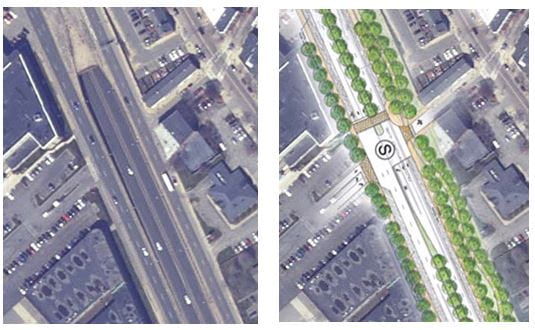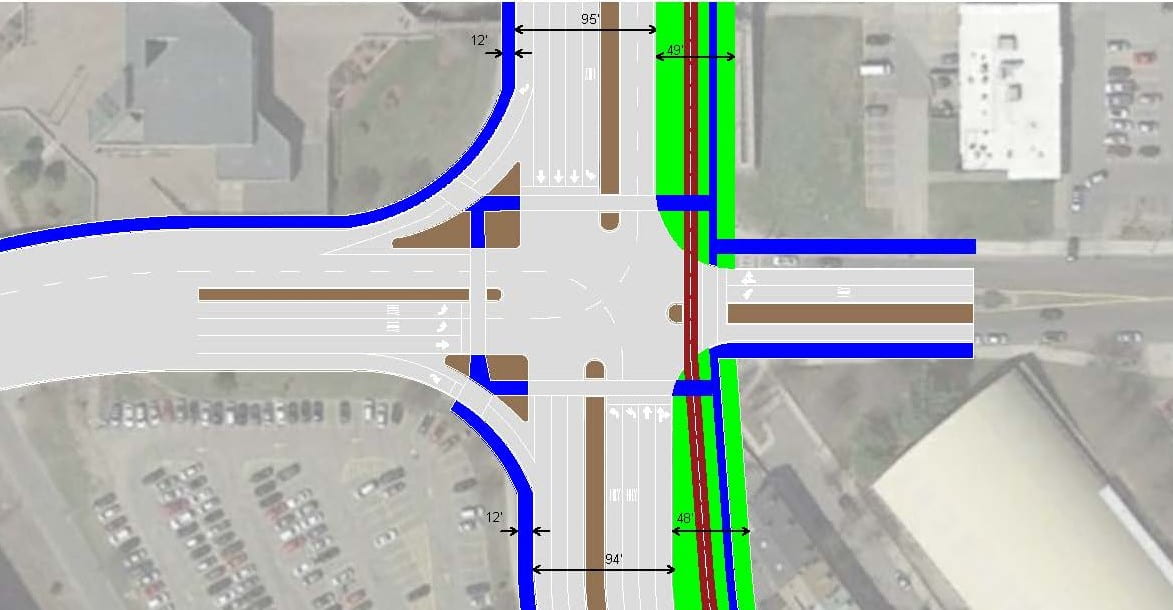(Editor’s note, 4/8/2018: Since this report was first published in February, 2018, we are glad to report that the Boston Transportation Department has modified its design by adding the delta islands that are part of our proposal, so that its plan now includes safe pedestrian crossings.)
Click here for a simulation video of the Surface Option during the a.m. peak, with traffic volumes as projected for the year 2040.
The City of Boston is planning now for a project intended to convert Rutherford Avenue in Charlestown from a wide highway into a boulevard with a linear park. The vision first presented to the public around 2010 was a boulevard with a wide linear park on the neighborhood side that would buffer the neighborhood from traffic while adding a much-needed recreation amenity and a missing link in the regional greenway network.
But in a major reversal, the City determined in May/June, 2017 that with the extra traffic expected from the casino in nearby Everett and other development, Rutherford Ave will need an underpass where it meets Austin Street, just as there is an underpass today. With an underpass, the linear park will be squeezed to about 20 ft wide – only enough space for a path for pedestrians and bikes to share and a narrow strip of grass on either side. The City also analyzed a surface option, but found that it had too little traffic capacity, resulting in enormous queues and delays. But it was a poisoned option, with only 5 lanes (2 lanes per direction, plus a left turn lane); less than a minute of calculations will show that 5 lanes could never carry the present traffic – much less future traffic – through the intersection at Austin Street. Yet that option had 65 ft of space left over for a linear park. Surely, I thought, by sacrificing a little bit of that space, a surface option could be found that has enough capacity AND still leaves ample space for a linear park! As an additional challenge, it has to be pedestrian-friendly.
The 5-Lane Surface Option: An Alternative that Works
My graduate student Amelia Chen (as of January, 2018, an intern with the City of Cambridge) and I worked on a design, and sure enough, we found a surface option that works. It has enough traffic capacity, leaves 49 ft on the neighborhood side for a linear park, and has pretty good pedestrian service. The layout of the intersection is shown below. Key performance measures, for the a.m. peak hour (the most congested part of the day), are:
| Maximum volume/capacity ratio, a.m. (p.m.) | 0.93 (0.95) |
| Average vehicular delay (s) | 48 (50) |
| Level of Service | D (D) |
| Average pedestrian crossing delay (s) | 30 |
Here’s a simulation video of the Surface Option during the a.m. peak, with traffic volumes as projected for the year 2040. One can see how the intersection handles all the traffic easilyand even has some surplus capacity.
Find the full report on the Surface Option here: Rutherford Ave @ Austin Surface Option report, NEU 2-26
Layout of the 5-lane surface option, with 5 thru lanes plus left-turn lanes
The Underpass Option: Worse in Almost Every Respect in Spite of Removing 40% of the Traffic
City officials have stressed that the underpass option is bound to be more pedestrian-friendly than a surface option because it removes so much traffic from the intersection. And it’s natural to think that an underpass option must be better for cars. And some people worry that if there isn’t an underpass, the neighborhood might be run over with traffic trying to avoid the congestion on Rutherford Ave.
However, an analysis of the underpass option reveals exactly the opposite:
- Three of the underpass option’s four pedestrian crossings are unsafe – that is, they involve conflicts with right turning traffic with traffic volumes nearly triple the limit allowed by MassDOT.
- While cars that can use the underpass will fly through unimpeded, the surface streets will face delays of 2 to 2.5 minutes, with queues on the Rutherford Ave surface roads growing to almost 500 ft in both directions.
- Far from protecting the neighborhood from cut-through traffic, the underpass option will actually create serious congestion that gives traffic heading to the Gilmore Bridge an incentive to cut through the neighborhood.
Find the full report analyzing the Underpass Option here: Underpass Option Impacts and Comparison, Rutherford @ Austin.
Below, reproduced from that report, is a summary of the impact comparison.
- Space for a linear park. The surface option leaves 49 ft for a linear park – enough for a walking path, a bicycle path, and 30 feet of green space separating them from traffic and from each other. The underpass option leaves only enough only for a path that pedestrians and bikes have to share, with only a narrow strip of green space separating them from the road.
- Traffic delay. Averaged over all vehicles, including those in the underpass, there is only an 8 s difference in average delay between the two alternatives. Of course, the underpass option offers an obvious advantage for long-distance through traffic using Rutherford Ave.; however, this advantage isn’t large, because in the surface option, delay to Rutherford’s through traffic is only about 40 s. Meanwhile, for traffic that has can’t use the underpass, the underpass option has serious capacity shortfalls that affect more than 1000 cars per hour and that result in delays greater than 2.5 minutes and queues almost 500 ft long on Rutherford Ave.’s two surface roads. The surface option has no capacity shortfalls, no long queues, and no long delays.
- Protecting the neighborhood from cut-through traffic by limiting traffic congestion. The underpass option results in serious congestion for traffic turning onto the Gilmore Bridge, with backups of almost 500 ft predicted on both surface roads. That will give traffic an incentive to divert to neighborhood streets. In the surface option, there is no such congestion. The delay to through traffic on Rutherford Ave is only 40 s, creating little incentive for people to divert to neighborhood streets.
- Access into and out of the neighborhood. With the underpass option, turns into the neighborhood and the traffic movement leaving the neighborhood on Austin Street are overcapacity, with long queues and long delays, while in the 7-lane surface option, all traffic movements into and out of the neighborhood have sufficient capacity. And the surface option creates additional intersections where neighborhood traffic can turn left onto Rutherford Ave (Lynde Street and Baldwin Street), easing the pressure on Austin Street and eliminating the need for U-turns at Austin Street.
- Pedestrian safety and convenience. With the underpass option, three out of the four legs of the intersection have crossings with unacceptably high right-turn conflicts, making them unsafe. At the same time, the longer signal cycle results in long pedestrian delays. With the surface option, all pedestrian crossings are safe from heavy turn conflicts and pedestrian delays are reasonable. And for people walking along Rutherford Ave., the surface option gives them a path separate from bicycles and far removed from the streets, while the underpass option puts them in a path shared with bicycles and far closer to the street.
- Flood control. The underpass option has far more impervious space than the surface option, increasing runoff that can lead to neighborhood flooding. During storm surges and heavy thunderstorms, the underpass is vulnerable to flooding.
- Noise and air pollution. With the surface option, the neighborhood is buffered from the street by a wide linear park, with ample space for trees that help capture particulates. With the underpass option, that buffer is only 21 ft wide, with limited green space for vegetation.
- Flexibility to adapt to future needs. The future is going to bring vast changes to transportation that are hard to predict. With a surface option, it would easy and relatively inexpensive to add an additional lane if traffic grows more than expected, and would likewise be easy to shrink the road if traffic grows less than expected, or if technology (connected vehicles, automated vehicles) makes traffic flow so much more efficient that fewer lanes needed. With an underpass option, the road layout is locked in – there is no room for further road expansion, nor would not be possible to shrink the road without getting rid of the underpass.
- Cost. The underpass option costs a lot more than a surface option. In any comparison of impacts, one should consider the benefits that could be obtained if MassDOT could save millions of dollars on this project and invest them elsewhere.
>> Return to the main page for the Rutherford Ave. / Sullivan Square project.

